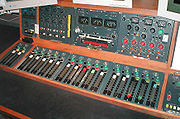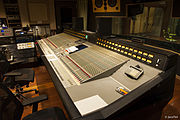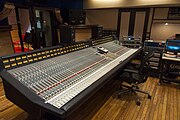用戶:DukeAnt/調音台

調音台(也叫混音器、混音台等),是一種在專業音頻領域中使用的用來對音頻信號進行混合(即混音),路由,調節音量、音色、動態範圍等的電子設備。依型號不同,調音台可用於模擬信號、數碼訊號。最後調整好的信號(電平或數字採樣)合到一起成為合成的輸出信號。
調音台應用到了很多地方,比如錄音棚、公共廣播系統、擴聲系統、廣播、電視以及電影後期製作等等。例如這樣簡單的應用場景:來自兩個話筒的聲音(比如二重唱),需要從同一套揚聲系統中同時聽到。在用於現場演出的時候,除非特定的調音台自帶功率放大功能或者連接到有源音箱,否則調音台所處理產生的信號一般是直接送到功率放大器的。在各種現場表演的盜錄中,質量最高的必然源自調音台對揚聲系統的輸出信號,即所謂調音台內錄[1][2]。
界面
[編輯]
典型的模擬調音台面板由三部分組成:
輸入通道條通常是一組相同的單聲道或立體聲輸入通道。Master控制部分有編組推子、Master推子、主混音總線控制和輔助返回音量控制[4]。此外還有SOLO監聽控制(獨奏監聽控制)、對講麥克風控制、啞音控制和輸出矩陣混音器。小一些的調音台,輸入在調音台面板的左邊,Master控制器在面板的右邊。大一些的調音台,Master控制器在面板的中央,而輸入在面板的兩側。音量表一般在輸入和主控部分的上方,或者整合在了輸入和主控部分中。
輸入通道條
[編輯]輸入通道條一般由以下部分組成:
為了便於區分和操作,一般這些區域會被標以不同的顏色。每個輸入都有自己的「通道」——視調音台型號不同,或是立體聲通道,或是單聲道通道。多數調音台的通道都有一個XLR母頭,有些還有RCA母頭[7]或TRS母頭[8](作為線路輸入接口)。
Basic input controls
[編輯]Below each input, there are usually several rotary controls (knobs, pots). The first is typically a trim or gain control. The inputs buffer the signal from the external device and this controls the amount of amplification or attenuation needed to bring the signal to a nominal level for processing. This stage is where most noise of interference is picked up, due to the high gains involved (around +50 dB, for a microphone). Balanced inputs and connectors, such as XLR or phone connectors, reduce interference problems.
There may be insert points after the buffer/gain stage, which send to and return from external processors which should only affect the signal of that particular channel. Effects that operate on multiple channels are connected to the auxiliary sends (below).
Auxiliary send routing
[編輯]The auxiliary send routes a split of the incoming signal to an auxiliary bus which can then be used with external devices. Auxiliary sends can either be pre-fader or post-fader, in that the level of a pre-fade send is set by the auxiliary send control, whereas post-fade sends depend on the position of the channel fader as well. Auxiliary sends can be used to send the signal to an external processor such as a reverb, which can then be routed back through another channel or designated auxiliary returns on the mixer. These will normally be post-fader. Pre-fade auxiliary sends can be used to provide a monitor mix to musicians onstage; this mix is thus independent of the main mix.
Channel equalization
[編輯]Further channel controls affect the equalization of the signal by separately attenuating or boosting a range of frequencies, e.g., bass, midrange, and treble. Many mixing consoles have a parametric equalizer on each channel. Some mixers have a general equalization control (either graphic or parametric) at the output.
Cue System
[編輯]The cue system allows the operator to listen to one or more selected signals without affecting the console's audio outputs. The signal from the cue system is fed to the console's headphone amp and may also be available as a line-level output that is intended to drive a monitor speaker system. The terms PFL (Pre Fade Listen) and AFL (After Fade Listen) are used to characterize the point in the signal flow from which the cue signal is derived. Input channels are usually configured as PFL so the operator can audition the channel without sending it to any mix. Consoles with a cue feature will have a dedicated button that is typically labeled "Cue" (although AFL, PFL, Solo and Listen are also used) on each channel.
Solo In Place (SIP) is a related feature found on more advanced consoles. It typically is controlled by the Cue button but unlike Cue, SIP is destructive of the output mix. Its purpose is to mute everything except the channel or channels that are being soloed. SIP is useful for setup and trouble-shooting in that it allows the operator to quickly mute everything but the signal being worked on. For obvious reasons, SIP is a function that would be dangerous to a mix engineer's career if engaged during performance. For this reason most consoles require very deliberate actions by the operator to engage SIP mode.
Subgroup and mix routing
[編輯]Each channel on a mixer has a sliding volume control (fader) that allows adjustment of the level of that channel. The signals are summed to create the main mix, or combined on a bus as a submix, a group of channels that are then added to get the final mix (for instance, many drum mics could be grouped into a bus, and then the proportion of drums in the final mix can be controlled with one bus fader).
There may also be insert points for a certain bus, or even the entire mix.
VCA groups
[編輯]Found on higher-end consoles, voltage-controlled amplifier (VCA) groups[note 1] function somewhat like subgroups but differ in important ways. VCA groups allow the level of multiple input channels to be controlled by a single fader. Unlike subgroups, no sub-mix is created. The audio signals from the assigned channels continue to be routed independently of VCA assignments. Since no sub-mix is created, it is not possible to insert processing such as compressors into a VCA/DCA group. In addition, on most VCA/DCA-equipped consoles any post-fader auxiliary send levels will be affected by the VCA master. Usually this is desirable as post-fader auxiliary sends are commonly used for effects such as reverb and sends to these effects should track changes in the channel signal level.
主輸出控制器
[編輯]編組和主輸出推子一般出現在在調音台面板的右側。大一些的調音台,主輸出推子在面板的中央,而輸入在面板的兩側。路由矩陣、耳機和監聽控制器通常也在這一區域。對講控制器控制控制表演者的監聽[9]、耳機或耳塞。測試音發生器和輔助返回[4]通常也在這一區域。
音量表
[編輯]調音台上通常有一個或多個VU表、峰值表用來監控每個通道及主輸出的音量,並防止信號被削峰[10]。多數調音台除了主混音[11]外還至少有一個其他的輸出——或是獨立的總線輸出,或是「輔助輸出」,例如用來輸出和舞台監聽不同的混音。
人對聲音的感知,更接近與強度、頻率的對數成正比而不是強度值、頻率值本身,因而調音台總是以分貝為單位控制和顯示這些參數。由於分貝是一種比值,音量表必須要有基準電平。所謂的「專業調音台」,基準電平一般為 +4 dBu,而所謂的「民用級調音台」,基準電平一般為 -10 dBv。
Hardware routing and patching
[編輯]For convenience, some mixing consoles include inserts or a patch bay or patch panel. Patch bays are mainly used for recording mixers.
Other features
[編輯]Most, but not all, audio mixers can
- add external effects.
- use monaural signals to produce stereo sound through pan and balance controls.
- provide phantom power required by some microphones.
Some mixers can
- create an audible tone via an oscillator.
- add effects internally.
- read and write console automation.
- be interfaced with computers or other recording equipment (to control the mixer with computer presets, for instance).
- control or be controlled by a digital audio workstation via MIDI or proprietary commands.
- be powered by batteries.
Digital versus analog
[編輯]
Digital mixing console sales have increased dramatically since their introduction in the 1990s. Yamaha sold more than 1000 PM5D mixers by July, 2005,[12] and other manufacturers are seeing increasing sales of their digital products. Digital mixers are more versatile than analog ones and offer many new features, such as reconfigure signal routing at the touch of a button. In addition, digital consoles often include processing capabilities such as compression, gating, reverb, automatic feedback suppression and delay. Some products are expandable via third-party software features (called plugins) that add further reverb, compression, delay and tone-shaping tools. Several digital mixers include spectrograph and real time analyzer functions. A few incorporate loudspeaker management tools such as crossover filtering and limiting. Digital signal processing can perform automatic mixing for some simple applications, such as courtrooms, conferences and panel discussions. Consoles with motorized faders can read and write console automation.
Propagation delay
[編輯]Digital mixers have an unavoidable amount of latency or propagation delay, ranging from 1.5 ms to as much as 10 ms, depending on the model of digital mixer and what functions are engaged. This small amount of delay is not a problem for loudspeakers aimed at the audience or even monitor wedges aimed at the artist, but can be disorienting and unpleasant for IEMs (In-ear monitors) where the artist hears their voice acoustically in their head and electronically amplified in their ears but delayed by a couple of milliseconds.
Every analog to digital conversion and digital to analog conversion within a digital mixer entails propagation delay. Audio inserts to favorite external analog processors make for almost double the usual delay. Further delay can be traced to format conversions such as from ADAT to AES3 and from normal digital signal processing steps.
Within a digital mixer there can be differing amounts of latency, depending on the routing and on how much DSP is in use. Assigning a signal to two parallel paths with significantly different processing on each path can result in extreme comb filtering when recombined. Some digital mixers incorporate internal methods of latency correction so that such problems are avoided.
Ease of use
[編輯]
Analog consoles remain popular due to their continuing to have one knob, fader or button per function, a reassuring feature for the user. This takes up more physical space but allows more rapid response to changing performance conditions. Most digital mixers take advantage of the technology to reduce the physical space requirements of their product, entailing compromises in user interface such as a single shared channel adjustment area that is selectable for only one channel at a time. Additionally, most digital mixers have virtual pages or layers which change the fader banks into separate controls for additional inputs or for adjusting equalization or aux send levels. This layering can be confusing for operators.
Analog consoles make for simpler understanding of hardware routing. Many digital mixers allow internal reassignment of inputs so that convenient groupings of inputs appear near each other at the fader bank, a feature that can be disorienting for persons having to make a hardware patch change.
On the other hand, many digital mixers allow for extremely easy building of a mix from saved data. USB flash drives and other storage methods are employed to bring past performance data to a new venue in highly portable manner. At the new venue, the traveling mix technician simply plugs the collected data into the venue's digital mixer and quickly makes small adjustments to the local input and output patch layout, allowing for full show readiness in very short order.
Some digital mixers allow offline editing of the mix, a feature that lets the traveling technician use a laptop to make anticipated changes to the show while en route, further shortening the time it takes for the sound system to be ready for the artist.
Sound quality
[編輯]Both digital and analog mixers rely on analog microphone preamplifiers, a high-gain circuit that increases the low signal level from a microphone to a level that is better matched to the console's internal operating level. In this respect, both formats are on par with each other. In a digital mixer, the microphone preamplifier is followed by an ADC which quantizes the audio stream. Ideally, this process is carefully engineered to deal gracefully with overloading and clipping while delivering an accurate digital stream over the linear dynamic range. Further processing and mixing of digital streams within a mixer need to avoid clipping and truncation if maximum audio quality is desired.
Analog mixers, too, must deal gracefully with overloading and clipping at the microphone preamplifier and as well as avoiding overloading of mix buses. Background hiss in an analog mixer is always present, though good gain stage management minimizes its audibility. Idle subgroups left "up" in a mix will add their background hiss to the main outputs; many digital mixers avoid this problem by low-level gating. Digital circuitry is more resistant to outside interference from radio transmitters such as walkie-talkies and cell phones.
Many electronic design elements combine to affect perceived sound quality, making the global "analog mixer vs. digital mixer" question difficult to answer. Controlled ABX double-blind listening tests have not been published at this date; no conclusive answer can be reached. Experienced live sound professionals agree that microphones and loudspeakers (with their innate higher distortion levels) are a much greater source of coloration of sound than the choice of mixer. The mix style of the person mixing is also more important than the make and model of audio console. Analog and digital mixers both have been associated with extremely high-quality concert performances and studio recordings.
Remote control
[編輯]Analog mixing in live sound has had the option since the 1990s of using wired remote controls for certain digital processes such as monitor wedge equalization and parameter changes in outboard reverb devices. That concept has expanded until wired and wireless remote controls are being seen in relation to entire digital mixing platforms. It's possible to set up a sound system and mix via wireless (or wired) laptop, touchscreen or tablet, especially if the performance requires no unpredictable fast responses to multiple changing conditions on stage. Computer networks can connect digital system elements for expanded monitoring and control, allowing the system technician to make adjustments to distant devices during the performance. The use of remote control technology can be utilized to reduce "seat-kills", allowing more paying customers into the performance space.
Software mixers
[編輯]For recorded sound, the mixing process can be performed on screen, using computer software and associated input, output and recording hardware. The traditional large control surface of the mixing console is not utilized, saving space at the engineer's mix position. In a software studio, there is either no physical mixer fader bank at all or there is a compact group of motorized faders designed to fit into a small space and connected to the computer via USB or Firewire. Many project studios use such a space-efficient solution, as the mixing room at other times can serve as business office, media archival, etc. Software mixing is heavily integrated as part of a digital audio workstation.
Applications
[編輯]Public address systems use a mixing console to set microphones to an appropriate level, and can add in recorded sounds into the mix. A major requirement is to minimise audio feedback.
Most bands use a mixing console to combine musical instruments and vocals.
Radio broadcasts use a mixing desk to select audio from different sources, such as CD players, telephones, remote feeds, or prerecorded advertisements. These consoles, often referred to as "air-boards" are apt to have many fewer controls than mixers designed for live or studio production mixing, dropping pan/balance, EQ, and multi-bus monitoring/aux feed knobs in favor of cue and output bus selectors, since, in a radio studio, nearly all sources are either prerecorded or preadjusted.
Dub producers/engineers such as Lee "Scratch" Perry were perhaps the first musicians to use a mixing board as a musical instrument.
Noise music musicians may create feedback loops within mixers, creating an instrument known as a no-input mixer. The tones generated from a no-input mixer are created by connecting an output of the mixer into an input channel and manipulating the pitch with the mixer's dials.
Gallery
[編輯]-
BBC Local Radio Mark III radio mixing desk
-
Allen & Heath Mixing desk used for live performances.
-
Mackie CR1604-VLZ mixing console used in a home studio
-
Solid State Logic SL9064J
-
Solid State Logic SL4064G+
-
Focusrite Console 72in 48out with GML Fader Automation
Mixing console manufacturers
[編輯]- Alesis
- Allen & Heath
- Audient
- Audix Broadcast Ltd
- Automated Processes, Inc.
- AMS Neve
- Avid
- Behringer
- Cadac Electronics
- Clarec
- Carvin A&I
- Crest Audio
- D&R
- DiGiCo
- Digidesign
- Deubner Hoffmann Digital (DHD)
- Electro-Voice
- Euphonix
- Fairlight
- Focusrite
- Daniel Flickinger
- Harris Corporation
- Harrison Audio Consoles
- Klotz Digital
- Lawo
- Logitek
- Mackie
- MCI
- Midas Consoles
- Peavey
- Phonic Corporation
- Pioneer Corporation
- Presonus
- Rane Corporation
- Roland Corporation
- Roland Systems Group
- Samick
- Samson Technologies
- Shure
- Solid State Logic (SSL)
- Soundcraft
- Speck Electronics
- Studer
- Studiomaster
- Tapco
- Tascam
- Ward-Beck Systems
- Yamaha Pro Audio
- Yorkville
See also
[編輯]Notes
[編輯]- ^ On some systems the feature is known as digitally-controlled amplifier (DCA) groups.
References
[編輯]- ^ Shambro, Joe. How To Record a Live Concert: Capturing Your Gig On tape. About.com. [October 18, 2012].
- ^ UrbanSteel. Explanation about Matrix/ALD/IEM/Soundboard. U2start.com. March 17, 2009 [October 18, 2012].
- ^ fader譯作電位器、衰減器,在中國大陸俗稱「推子」。本文使用推子這種譯法。
- ^ 4.0 4.1 控制外置效果器返回的信號。
- ^ preamplifier譯作前級放大器或前置放大器
- ^ panning control,譯作聲相控制器或聲像控制器
- ^ 在中國大陸俗稱蓮花頭
- ^ 在中國大陸,6.35 mm TRS俗稱大三芯,3.5 mm TRS俗稱小三芯
- ^ 見條目監聽 (音頻工程)
- ^ 參見削峰 (音頻)
- ^ main mix,主混音,和主輸出對應。
- ^ Yamaha PM5D Sales Top 1,000 Units












